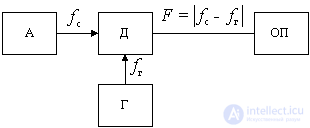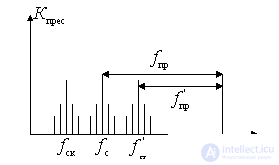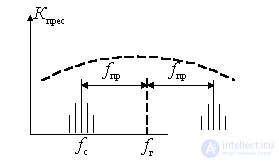Lecture
In a superheterodyne receiver, high-frequency amplification and selectivity are performed not only at the frequency of the received signal.  but also at some intermediate frequency
but also at some intermediate frequency 
The superheterodyne receiver circuit includes:
- an input antenna that transforms an electromagnetic wave into a radio signal;
- an input device (input circuit) providing frequency selectivity;
- USCH (resonant amplifier), providing amplification at the signal frequency  and by this
and by this
contributing to a given sensitivity;
- a frequency converter consisting of a local oscillator and a mixer. The purpose of the inverter is to replace
carrier frequency  to a constant lower frequency
to a constant lower frequency  ;
;
- UPCH - amplifier whose load is band-pass filters with a fixed setting.
HRO makes a major contribution to ensuring a given sensitivity and selectivity;
- detector;
- UZCH;
- OP.

Figure 2.6.
Frequency conversion  at
at  is carried out in the frequency converter of the inverter, consisting of the mixer C and the local oscillator G. The heterodyne generates collations
is carried out in the frequency converter of the inverter, consisting of the mixer C and the local oscillator G. The heterodyne generates collations  In the mixer, which is a non-linear element or element with periodically varying parameters, the combination frequencies are formed
In the mixer, which is a non-linear element or element with periodically varying parameters, the combination frequencies are formed  ,
,
where m and n are integers. One of these frequencies is used as an intermediate frequency. Usually the most convenient is the use of the difference frequency, i.e. is chosen

when the signal frequency changes  over the frequency range of the local oscillator
over the frequency range of the local oscillator  It also changes according to such a law that the intermediate frequency remains constant, i.e. according to law:
It also changes according to such a law that the intermediate frequency remains constant, i.e. according to law:

Where  On this constant intermediate frequency and contours of the amplifier are tuned. To increase the sensitivity and selectivity of the receiver, sometimes double or even triple frequency conversion is used.
On this constant intermediate frequency and contours of the amplifier are tuned. To increase the sensitivity and selectivity of the receiver, sometimes double or even triple frequency conversion is used.

Figure 2.7.
Receivers with frequency conversion were called superheterodyne in contrast to heterodyne receivers, in which the local oscillator is designed to highlight a low frequency when hearing the telegraph signals.

Figure 2.8.
The main advantages of superheterodyne compared with a direct gain receiver are:
1) Constancy  by range. Due to this, all circuits that are part of the HRO have a fixed setting and are simple in design, which allows using a large number of stages with resonant loops in the HRA. This makes it easier to obtain a large gain of high selectivity, and the electrical performance of the receiver as a whole becomes more constant over the entire range of received frequencies.
by range. Due to this, all circuits that are part of the HRO have a fixed setting and are simple in design, which allows using a large number of stages with resonant loops in the HRA. This makes it easier to obtain a large gain of high selectivity, and the electrical performance of the receiver as a whole becomes more constant over the entire range of received frequencies.
2) The possibility of obtaining an intermediate frequency  lower than the frequency of the received signal. Since the bandwidth of each resonant circuit is proportional to its resonant frequency (
lower than the frequency of the received signal. Since the bandwidth of each resonant circuit is proportional to its resonant frequency (  ), then lowering this frequency allows you to narrow the receiver bandwidth, which is especially important when receiving very high frequencies. Reducing the resonant frequency in some cases also facilitates the possibility of obtaining large and stable amplification, especially when receiving very high frequencies.
), then lowering this frequency allows you to narrow the receiver bandwidth, which is especially important when receiving very high frequencies. Reducing the resonant frequency in some cases also facilitates the possibility of obtaining large and stable amplification, especially when receiving very high frequencies.
3) The ability to implement amplification to the detector not only at the signal frequency  but also at a frequency significantly different from it
but also at a frequency significantly different from it  . This circumstance facilitates the obtaining of a very large steady gain (of the order of 1,000,000 or more), since the most dangerous are parasitic coupling, covering cascades with approximately the same resonant frequency.
. This circumstance facilitates the obtaining of a very large steady gain (of the order of 1,000,000 or more), since the most dangerous are parasitic coupling, covering cascades with approximately the same resonant frequency.
Thus, due to the features of the structural scheme, in a superheterodyne receiver is much simpler than in a direct gain receiver, a large gain, greater selectivity and constancy of electrical parameters are achieved.
Along with the great advantages, the superheterodyne receiver has, compared to the direct gain receiver, some disadvantages, the main of which are:
1) The need for an additional unit - frequency converter. This disadvantage may be significant in the design of simple receivers, which do not require high sensitivity and, consequently, high selectivity. In such cases, the transition from the direct amplification circuit may cause not a simplification, but an unjustified complication of the receiver.
2) Greater influence of internal noise in an active device operating in the frequency converter mode than in the same device operating in the amplification mode. To eliminate this drawback (in the case when the level of internal noise is comparable to the level of external noise), it is necessary to perform some signal amplification before frequency conversion so that the signal level exceeds the level of internal noise of the frequency converter.
3) The presence of spurious reception channels. When superheterodyne receive there are such frequencies  other than signal frequency
other than signal frequency  which are converted in the frequency converter to the same intermediate frequency as the signal frequency, and for which, therefore, the amplifier circuit does not have any selectivity. Such parasitic reception channels include adjacent, mirror, Raman, intermodulation, and direct.
which are converted in the frequency converter to the same intermediate frequency as the signal frequency, and for which, therefore, the amplifier circuit does not have any selectivity. Such parasitic reception channels include adjacent, mirror, Raman, intermodulation, and direct.
a) The adjacent receiving channel is a channel at frequencies  adjacent to the main channel (
adjacent to the main channel (  ), due to the lack of selectivity of the receiver, the non-filtered signal by the preselector and creating in the IF signals at frequencies
), due to the lack of selectivity of the receiver, the non-filtered signal by the preselector and creating in the IF signals at frequencies

close to the intermediate frequency and included in the bandwidth of the amplifier.

Figure 2.9.
b) The mirror receive channel is formed by external interference at the frequency  which is equal to
which is equal to


Figure 2.10.
If this frequency is in the bandwidth of a preselector having a frequency response  shown in the figure, the frequency is formed in the IF
shown in the figure, the frequency is formed in the IF

those. same as frequency

from the desired signal. Consequently, the spectrum of the useful signal and the interference spectrum overlap, frequency filtering of signal interference becomes impossible. There are two ways to loosen the interference in the image channel:
- an increase in the frequency selectivity of the preselector;
- increase in intermediate frequency 
In the latter case (with an increase in  ) according to the previously considered expression
) according to the previously considered expression

interference frequency will increase  that allows you to better filter it in the preselector. However, the higher
that allows you to better filter it in the preselector. However, the higher  the harder it is to ensure the high selectivity of the OO with bandwidth associated with the width of the spectrum of the useful signal. To eliminate interference at the same time in the mirror and adjacent channels, multiple frequency conversion (reduction) is applied:
the harder it is to ensure the high selectivity of the OO with bandwidth associated with the width of the spectrum of the useful signal. To eliminate interference at the same time in the mirror and adjacent channels, multiple frequency conversion (reduction) is applied:


c) The combination channel of reception is formed as a result of interaction between the combination frequencies of the local oscillator and the signal

where m , n > 1, forming frequencies close to  i.e. included in the bandwidth of the HRO. Amplifying in the same way as a useful signal at a frequency
i.e. included in the bandwidth of the HRO. Amplifying in the same way as a useful signal at a frequency

on the demodulator there are beats between the signal frequencies and the combination frequencies

If they are included in the passband of the low-frequency amplifier of the UZCH, then they are a disturbance reproduced further by the op-amp terminal.
The main measure to eliminate the combinational reception channel is to reduce the level of harmonics of the local oscillator and signal by selecting the appropriate mode of operation of the mixer.
d) The intermodulation reception channel occurs when two or more interferences at frequencies pass through the preselector
 ,
,
which in the mixer form signals with combinational frequencies
 (
(  - whole numbers).
- whole numbers).
If any one or several combinational frequencies falls within the IF bandwidth, an intermodulation reception channel is created.
To reduce the influence of the intermodulation channel, the frequency selectivity of the preselector should be increased and the gain in the RF amplifier should be reduced.
e) The direct receiving channel is formed when the interference has a frequency equal to the intermediate frequency.  , and, acting on the inverter, passes without converting the frequency to the IF channel. The main control measure is the use of resonant circuits, filtering this interference to the converter.
, and, acting on the inverter, passes without converting the frequency to the IF channel. The main control measure is the use of resonant circuits, filtering this interference to the converter.
When designing a superheterodyne receiver, side (spurious) reception channels can be practically eliminated by selecting the intermediate frequency, the mode of operation of the frequency converter, and the necessary frequency selectivity of the preselector and TFC. therefore, the superheterodyne structure of the receiver is currently the main one.
Comments
To leave a comment
Devices for the reception and processing of radio signals, Transmission, reception and processing of signals
Terms: Devices for the reception and processing of radio signals, Transmission, reception and processing of signals